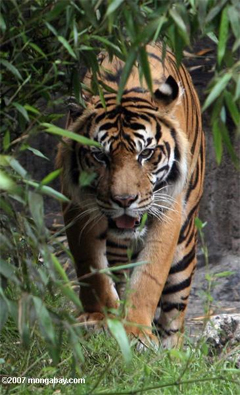<!DOCTYPE HTML PUBLIC "-//W3C//DTD HTML 3.2//EN">
Zoos: Why a Revolution is Necessary to Justify Them
Jeremy Leon Hance, mongabay.com
October 6, 2008
When the Grey Squirrel Met the Siberian Tiger
|
|
Watching a Siberian tiger kill a grey squirrel for a half-hour proved to be one of my most enlightening experiences at a zoo. It was a weekday; I was alone, not even an employee passed by. The tiger pounced on the squirrel, flipped it into the air like a juggler's ball, pinned it and rolled it. A short reprieve from this unlikely encounter and the bloodied, half-crushed squirrel attempted an escape, dragging itself across the grass; the tiger watched curiously, let it go a few feet then pounced again. My whole self suffered over the squirrel's pain and torture while marveling in the same instance at the tiger's power, the ease with which it knocked the rodent along the ground. Here in an institution where nature is faked was a relatively truthful half-hour: nature's brutality, grace, ugliness, awe, beauty, and tragedy were reveled. I never could conclude whether the Asian terror was just playing or if it simply lacked the knowledge (as has been proven with many captive cats) to finish off the squirrel. Either way, it took a long time for the rodent to die.
  At the zoo: tiger versus squirrel |
At 28 years of age I have spent countless hours in well over twenty zoos spanning four continents. I present this fact as the main expertise I posses in writing an essay analyzing contemporary zoos and their visitors. That is to say, this is not an exploratory essay of a professional zoologist or biologist (or even a science major), rather this is one zoo-goers and environmental reporter's view of the current state of zoos and, more importantly and rarely discussed, some general ideas that could transform the zoo's place in our society. This is my hope. Due to the desire to avoid a dissuadable length, I will not evaluate zoos separately (though of course they vary widely in quality), but rather sketch a general impression.
The True Purpose of Zoos
Think about it: the zoological park—in which living beings are subjected to strict confinement, where they must live a life, no matter the size and 'naturalness' of the cage, wholly different from the natural one to which they are suited, where their instincts are dulled, tamed, and corrupted: eating involves no hunting or foraging and sexual relations are interfered with and closely monitored—allows such seemingly needless suffering to fellow creatures that we, as ethical (hopefully) animals, must not only supply a very good reason for this subjection, but also achieve it.
Zoos have a long history. China claims the first (as it does with most public institutions), but Egypt, Greece, and Rome all possessed zoos of a kind. However our contemporary zoos are direct descendants of Europe's first public zoos (replacing royal menageries meant only for the aristocratic class). A product of the European Enlightenment, late 18th Century zoos were built with the purpose to harbor animals for scientific purposes and public education. These were noble ideas, but it would be two-hundred years before zoos began to consider the health and sanity of its inmates. At the same time, circa 1960s and 70s, zoos began to rethink their general purpose. It was quite clear at this point that the earth was on the verge of a global extinction, called the Holocene Mass Extinction, and only strong efforts by scientists and societies at large could save the vast biodiversity of our planet. Contemporary zoological parks have added stipulations regarding species health and well-being, while embracing the idea that they must focus on conservation efforts worldwide and environmental education locally. This is a purpose that makes sense. In fact this is the only reason to allow such unnatural captivity: the zoo should be a local Conservation Center, focusing wholly on saving (or reinstating) species in the wild and on educating the public on the importance of conservation and biodiversity. AZA (the accrediting Association of Zoos and Aquariums) exists to make this happen, and there are many quality conservation programs going in and coming out of most zoos. My skepticism lies not so much with zoo's conservation programs, but with their effectiveness as educators.
Zoo: The Educational Institution?
It appears that most zoos believe the animals themselves are sufficient education: somehow by seeing a bear in a cage one will be environmentally enlightened. Yet what do captive animals—lacking context—teach one about the natural world and its importance? The zoo is an artificial 'wilderness'; it is man-made and man-managed. There is no connection between a pen and an ecosystem. A visitor can look through the glass and see an insect, a snake, a reptile and 'learn' nothing more than: they are boring, because they just sit there. In the same manner polar bears appear as playful, cute, and hardly menacing, though they can kill a two-hundred pound seal (or human) with one hit from the paw. Finally, it's difficult to wrap one's head around an animal being endangered when its three feet from you. Without context—without quality information in a wide variety of forms—zoos only teach us illusions regarding nature and conservation, yet many zoos still believe that the caged animal will say it all. If this were true then according to my experience the main prey of Siberian Tigers would be the North American Gray Squirrels.
The rest of this article is now only available to subscribers. An updated version is also published in Jeremy Hance’s book, Life is Good: Conservation in an Age of Mass Extinction, which was released in January 2012.